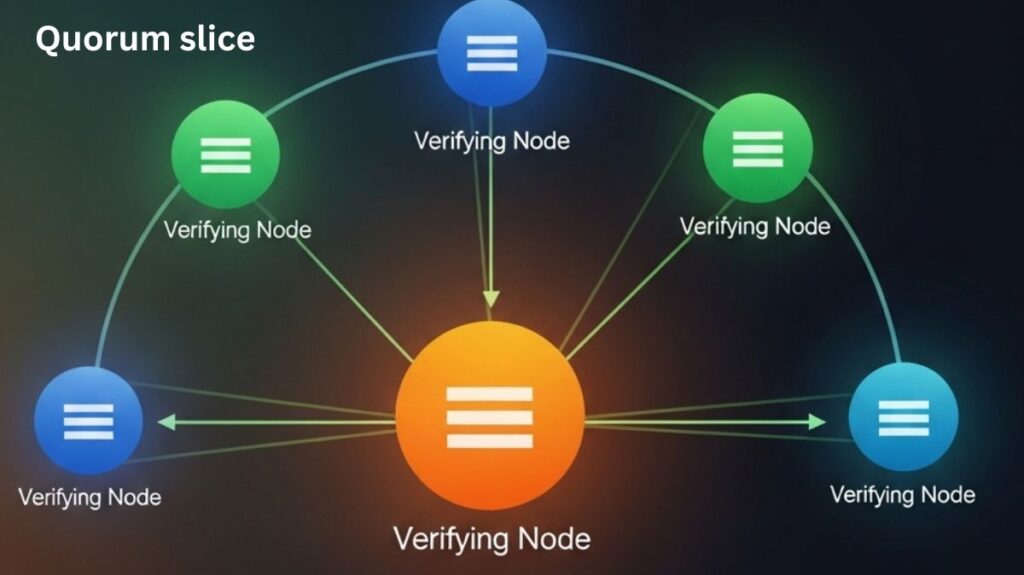Quorum slice

A key idea in some distributed ledger technologies, especially in the Stellar Consensus Protocol (SCP) and other decentralised consensus systems, is a quorum slice.
Definition
A collection of nodes used by a particular verifying node to communicate with other verifying nodes in the network is known as a quorum slice. A subset of nodes in a network that a specific node trusts to come to an agreement is another way to define it.
Purpose
Its main objective is to assist a node in coming to an agreement. To persuade a few nodes to concur, quorum slices subsets of a larger “quorum” are used. Individual verifier nodes’ quorum slices work together to link the network as a whole to create a quorum, which allows the network to agree on a transaction. A node may rely on many quorum slices for information.
Trust Model and Functionality
Every node in this system chooses for itself which other nodes to trust. The quorum slice of that node is then made out of this collection of reliable nodes. Adaptability and flexibility are made possible by this decentralised strategy. Any node that wants to validate a transaction needs the consent of all the other nodes in its particular quorum slice. Only when every node in the quorum slice of a transaction properly verifies it is it considered valid. Establishing trust takes place inside the node’s configuration file.
Relationship with Quorums
A smaller, reliable group of nodes within a larger quorum is called a quorum slice. A quorum is a larger number of nodes needed for consensus. Each cluster node has at least one quorum slice, ensuring that enough nodes agree on a state for consensus. Valid quorums must have one slice per cluster node. An update on the state will be accepted as legitimate if a certain number of nodes in a quorum are reached. The global quorum of the network is formed by the choices made by nodes regarding their trustworthy entities. The example shows this: Slice {A, B, C} and {B, C, D} can be constructed by nodes A and D trusting nodes B and C, respectively. Because they trust B and C, A and D can concur despite their lack of direct trust.
Hierarchical Structure and Dynamic Formation
- It is possible to arrange quorum slices in a hierarchical fashion. For example, the first chance to validate transactions would go to the highest level of this structure.
- “Node 1” forming quorum slices with “Group 1” and “Group 2” (top-tier groups) is an example given, but “Group 3” may be at a lower level. For a transaction to be deemed legitimate, “Node 10” from “Group 3” must persuade nodes from “Group 1” (such as node 1, node 3) and “Group 2” (such as node 6) to cooperate if it requires services from the top-tier groups for transaction verification.
- Without a central authority controlling the list, nodes can add additional trustworthy nodes from which they need services, allowing them to participate in consensus and dynamically build slices. A more natural and dispersed quorum formation is made possible by this dynamic formation.
Also Read About What Is ewasm Ethereum WebAssembly In Blockchain
Comparison with Ripple’s Unique Node List (UNL)
- Similar to how Ripple uses a Unique Node List (UNL) for transaction validation, Stellar uses quorums.
- Every node in Ripple keeps its own UNL, which is made up of nodes it trusts. At least 80% of the nodes in a UNL must approve a transaction for it to be confirmed in Ripple. This suggests that for a transaction to be approved, at least one-fifth of all nodes in a UNL must be malicious-free. As long as the malicious nodes are fewer than or equal to (4n + 1)/5 of the total nodes (n) within the UNL, the system strives for accuracy even if the number of malicious nodes rises.
Importance and Challenges
- Because they enable nodes to verify information based on their unique trust relationships rather than depending on a single, central authority, quorum slices are essential for reaching consensus in decentralised systems.
- The Federated Byzantine Agreement (FBA) paradigm allows for the more decentralised and organic production of quorums by relying on individual nodes to choose their own sets of quorum slices.
- When discussing safety and liveness in the FBA, it’s critical to assess quorum intersection and disjoint quorums.
- Overlapping quorums result from good quorums sharing nodes. Nodes are in charge of choosing quorum slices without going against quorum intersection.
- Quorums that do not intersect, or disjoint quorums, are bad because they can provide contradicting claims and erode consensus.
- When choosing slices, nodes have to strike a balance between safety and liveness.
- Nodes that externalise values that conflict with those of other nodes lose their safety.
- If nodes are prevented from coming to a consensus, there is no liveness.
- In order for nodes to agree on a statement, the Federated Voting paradigm is essential.
Also Read About Horizontal Vs Vertical Sharding: Database Scaling Explained
